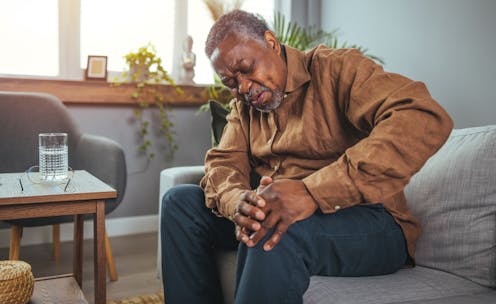Sore joints now it's getting cold? It's tempting to be less active – but doing more could help you feel better
- Written by Charlotte Ganderton, Senior Lecturer (Physiotherapy), RMIT University

One in three[1] Australians has a musculoskeletal condition involving joint pain, and the most common cause is arthritis. Around 3.6 million[2] Australians have arthritis and this is projected to rise to 5.4 million by 2030[3].
For some people with joint pain, cold weather seems to make it worse[4]. But temperature is just one factor[5] impacting perceptions of greater pain[6] during winter. Other factors include those we have some level of influence over, including sleep[7], behavioural patterns, mood[8] and physical activity[9]. Emerging research suggests greater pain levels in winter may also be related to a person’s perception of the weather[10], lack of vitamin D[11] and fluctuations in their disease[12].
Physical activity[13] is one of the best treatments to increase function, strength and mobility – and improve quality of life. It also promotes[14] mental and physical health and reduces the risk[15] of other chronic diseases.
But pain can be a barrier to exercise and activities you’d usually do. So what can you do about it?
Our brain tries to protect us
When it comes to pain, our brain is very protective: it’s like an inbuilt alarm system and can warn us about impending danger or harm that has occurred so we can respond.
But it’s not always a reliable indicator of actual damage or trauma to the skin, muscle or bone, even when it feels like it is. In some instances, this warning system can become unhelpful by setting off “false alarms”.
Read more: Turning down the volume of pain – how to retrain your brain when you get sensitised[16]
Joint pain and stiffness can also appear to worsen during colder weather, prompting fears[17] we could make it worse[18] if we undertake or overdo movement. This can result in[19] people avoiding physical activity – even when it would be beneficial – which can worsen the pain.
We tend to exercise less when it’s cold
Seasons affect[20] how much physical activity we get. Summer months bring warmer weather, longer daylight hours and people get outdoors more. Warmer weather also tends to elicit a positive outlook, a lift in mood and burst of physical activity to fulfil New Year’s resolutions.
Cooler months can mean a decline in physical activity and more time being cosy indoors. A reduction in movement and less exposure to light may evoke higher levels of joint pain and can be associated with a reduction in our overall sense of well-being and mood.
This can create a cycle where symptoms worsen over time.
But with the right knowledge and support, people can remain engaged in an active lifestyle[22] especially when it’s aligned to personal values and goals. Health professionals such as physiotherapists and GPs can assess any concerns and provide strategies that are right for you.
How to motivate yourself to stay active in winter
When looking for an approach to help you stay active during the cooler months and beyond, it can be helpful to become aware of the many interconnected factors[23] that impact you. They include:
- biological (your genes, other illnesses you have)
- psychological (how you think, feel and behave)
- social (your relationships and social support).
Starting with the end goal in mind can be beneficial, but this can feel overwhelming. Try creating smaller, achievable steps to help get you there, like climbing a ladder. For example, park a short distance from the shops and increase this incrementally to increase your exercise tolerance.
A little bit each day can often be less tolling on your body than a big effort once a week.
Read more: How do I improve my motivation to exercise when I really hate it? 10 science-backed tips[24]
Create goals that are personally meaningful and encourage you to celebrate success along the way (for example, catching up with friends or a healthy snack). Then, as you climb your “ladder”, one rung at a time, you will likely feel more motivated to continue.
If you’re not sure where to start, talk to a friend or health provider to help you determine what is realistic and right for your situation. That way you can work towards your goals in a safe, non-threatening environment[25] and avoid developing fear and avoidance. They can also help you establish goals that align with your aspirations and pain experience.
References
- ^ One in three (www.health.gov.au)
- ^ 3.6 million (arthritisaustralia.com.au)
- ^ 5.4 million by 2030 (www.arthritiswa.org.au)
- ^ seems to make it worse (doi.org)
- ^ is just one factor (doi.org)
- ^ greater pain (doi.org)
- ^ sleep (link.springer.com)
- ^ behavioural patterns, mood (link.springer.com)
- ^ physical activity (link.springer.com)
- ^ perception of the weather (doi.org)
- ^ vitamin D (doi.org)
- ^ fluctuations in their disease (doi.org)
- ^ Physical activity (doi.org)
- ^ promotes (doi.org)
- ^ reduces the risk (www.sciencedirect.com)
- ^ Turning down the volume of pain – how to retrain your brain when you get sensitised (theconversation.com)
- ^ fears (doi.org)
- ^ make it worse (doi.org)
- ^ can result in (doi.org)
- ^ affect (doi.org)
- ^ Shutterstock (www.shutterstock.com)
- ^ can remain engaged in an active lifestyle (doi.org)
- ^ interconnected factors (doi.org)
- ^ How do I improve my motivation to exercise when I really hate it? 10 science-backed tips (theconversation.com)
- ^ work towards your goals in a safe, non-threatening environment (doi.org)
















